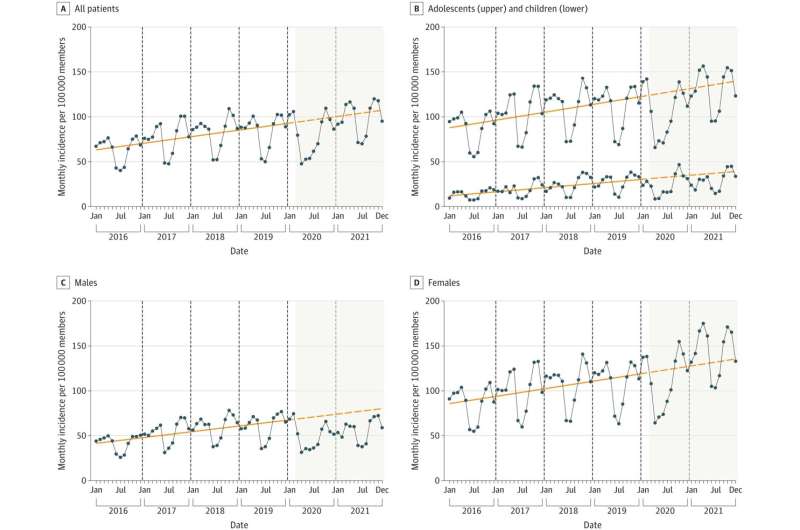This article has been reviewed according to Science X's editorial process and policies. Editors have highlighted the following attributes while ensuring the content's credibility:
fact-checked
peer-reviewed publication
trusted source
proofread
New study explores seasonality of teen suicidality

The incidences of teen suicidality including self-harm, suicidal ideation, and suicide attempts increased nationally between 2016 and 2021; were at seasonal high peaks in April and October; and were at their lowest when schools were shut down during the COVID-19 pandemic, according to research at UTHealth Houston.
The study was published this month in JAMA Network Open. It was authored by Youngran Kim, Ph.D., assistant professor in the Department of Management, Policy, and Community Health at UTHealth Houston School of Public Health; Scott D. Lane, Ph.D., professor and vice chair for research in the Louis A. Faillace, MD, Department of Psychiatry and Behavioral Sciences with McGovern Medical School at UTHealth Houston; and Trudy Millard Krause, DrPH, professor in the Department of Management, Policy, and Community Health at the School of Public Health and co-director at the Center for Health Care Data.
"There is a clear pattern of suicidality related to the academic calendar. When that pattern was disrupted during COVID-19 and a change in the school calendar occurred, it clearly affected suicidal behavior," Kim said.
"We were initially motivated to determine if there was an increasing trend in youth self-harm and suicide ideation or attempt over the past five years, and we did in fact confirm a year-over-year increase—except 2020," said Lane, who is also director of research for the UTHealth Houston Behavioral Sciences Campus.
"In 2020, we were provided with a rare natural experiment, in which the entire school system was shut down across the country. It was an opportunity to examine seasonality corresponding to the school calendar. It just happened that the school closure occurred during months in which suicidality normally peaks. In fact, we observed a decline in the spring when schools were closed, where we otherwise would predict an increase."
In the cross-sectional study, researchers looked at 73,123 emergency department visits and hospitalizations that occurred among more than a million youth and adolescents each year for suicidality between 2016 and 2021. The national database is administrated by Krause.
Among these events, nearly 66% were females with the average age of 15. From 2016 to 2019, there was an increase in incidence from 760 per 100,000 to 1,006 per 100,000. During the COVID-19 pandemic, there was a temporary decrease to 942 per 100,000 and then a jump to 1,160 per 100,000 in 2021.
"There was a linear trend where the increase was consistent from 2016 to 2019, and then a drop in 2020. However, the rebound in 2021 did not resume along that trend line, it actually overshot it," Lane said. "We found a post-COVID increase in suicidality beyond what would be expected, and it was particularly salient in females."
During pre-COVID-19 years and 2021, seasonal patterns showed peaks in April and October with a dramatic low in the summer months. consistent with the school calendar. However, for the spring of 2020, during the time when schools were shut down, April and May had the lowest rates.
Given the findings, researchers suggest interventions during the peak months of April and October, especially for adolescent females, could help in protect against seasonal increases in suicidality.
"If I were a provider or a public health official interested in suicidality, I might emphasize programs that recognize the increased risk in adolescent females post-COVID," Lane said. "Or at least have specialized interventions that are aware of the uniqueness of female suicidality in youth."
A limitation of the study is that the data only looked at the suicidality in youth with health insurance, who presented to an emergency department or were directly hospitalized. The data did not include those who were uninsured or had federal or state-supported health insurance. Also, while suicidality is among the best predictors of completed suicide, the study did not measure completed suicides because those records do not go to the insurance database used in the report.
More information: Youngran Kim et al, Trends and Seasonality of Emergency Department Visits and Hospitalizations for Suicidality Among Children and Adolescents in the US from 2016 to 2021, JAMA Network Open (2023). DOI: 10.1001/jamanetworkopen.2023.24183. jamanetwork.com/journals/jaman … /fullarticle/2807435




















